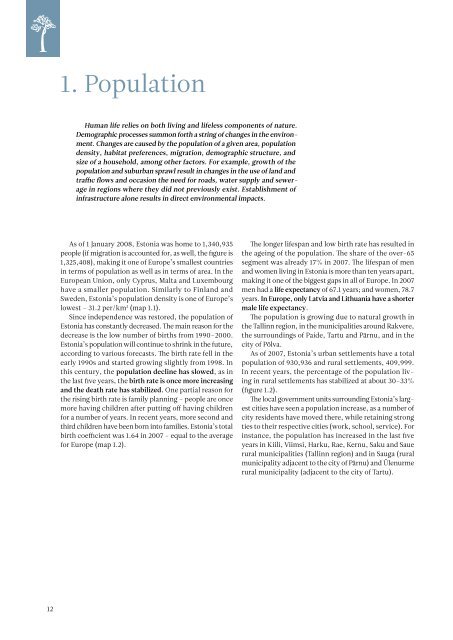ESTONIAN ENVIRONMENTAL REVIEW 2009
ESTONIAN ENVIRONMENTAL REVIEW 2009
ESTONIAN ENVIRONMENTAL REVIEW 2009
You also want an ePaper? Increase the reach of your titles
YUMPU automatically turns print PDFs into web optimized ePapers that Google loves.
1. Population<br />
Human life relies on both living and lifeless components of nature.<br />
Demographic processes summon forth a string of changes in the environment.<br />
Changes are caused by the population of a given area, population<br />
density, habitat preferences, migration, demographic structure, and<br />
size of a household, among other factors. For example, growth of the<br />
population and suburban sprawl result in changes in the use of land and<br />
traffic flows and occasion the need for roads, water supply and sewerage<br />
in regions where they did not previously exist. Establishment of<br />
infrastructure alone results in direct environmental impacts.<br />
As of 1 January 2008, Estonia was home to 1,340,935<br />
people (if migration is accounted for, as well, the figure is<br />
1,325,408), making it one of Europe’s smallest countries<br />
in terms of population as well as in terms of area. In the<br />
European Union, only Cyprus, Malta and Luxembourg<br />
have a smaller population. Similarly to Finland and<br />
Sweden, Estonia’s population density is one of Europe’s<br />
lowest – 31.2 per/km 2 (map 1.1).<br />
Since independence was restored, the population of<br />
Estonia has constantly decreased. The main reason for the<br />
decrease is the low number of births from 1990–2000.<br />
Estonia’s population will continue to shrink in the future,<br />
according to various forecasts. The birth rate fell in the<br />
early 1990s and started growing slightly from 1998. In<br />
this century, the population decline has slowed, as in<br />
the last five years, the birth rate is once more increasing<br />
and the death rate has stabilized. One partial reason for<br />
the rising birth rate is family planning – people are once<br />
more having children after putting off having children<br />
for a number of years. In recent years, more second and<br />
third children have been born into families. Estonia’s total<br />
birth coefficient was 1.64 in 2007 – equal to the average<br />
for Europe (map 1.2).<br />
The longer lifespan and low birth rate has resulted in<br />
the ageing of the population. The share of the over-65<br />
segment was already 17% in 2007. The lifespan of men<br />
and women living in Estonia is more than ten years apart,<br />
making it one of the biggest gaps in all of Europe. In 2007<br />
men had a life expectancy of 67.1 years; and women, 78.7<br />
years. In Europe, only Latvia and Lithuania have a shorter<br />
male life expectancy.<br />
The population is growing due to natural growth in<br />
the Tallinn region, in the municipalities around Rakvere,<br />
the surroundings of Paide, Tartu and Pärnu, and in the<br />
city of Põlva.<br />
As of 2007, Estonia’s urban settlements have a total<br />
population of 930,936 and rural settlements, 409,999.<br />
In recent years, the percentage of the population living<br />
in rural settlements has stabilized at about 30–33%<br />
(figure 1.2).<br />
The local government units surrounding Estonia’s largest<br />
cities have seen a population increase, as a number of<br />
city residents have moved there, while retaining strong<br />
ties to their respective cities (work, school, service). For<br />
instance, the population has increased in the last five<br />
years in Kiili, Viimsi, Harku, Rae, Kernu, Saku and Saue<br />
rural municipalities (Tallinn region) and in Sauga (rural<br />
municipality adjacent to the city of Pärnu) and Ülenurme<br />
rural municipality (adjacent to the city of Tartu).<br />
12

















